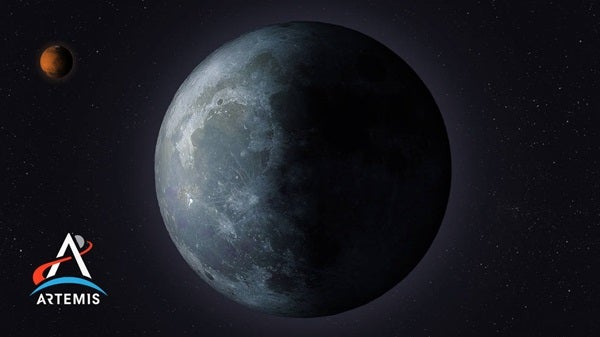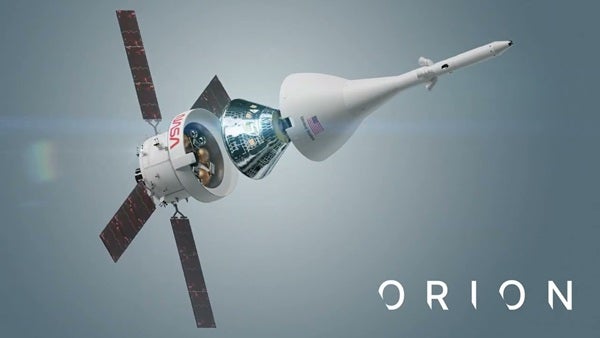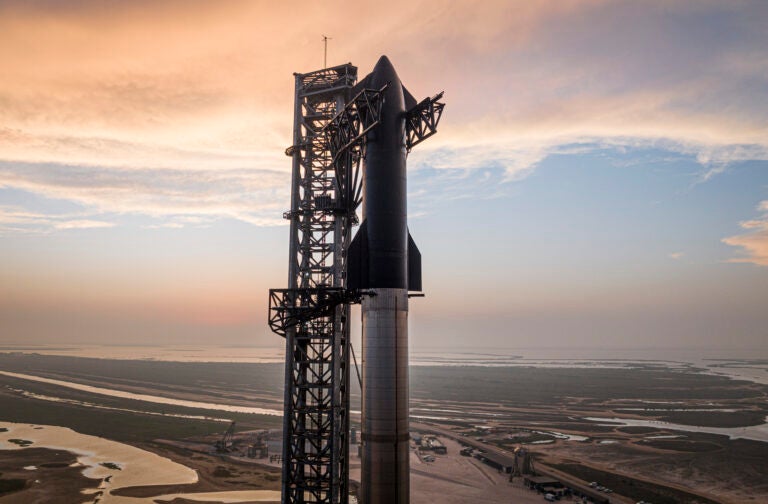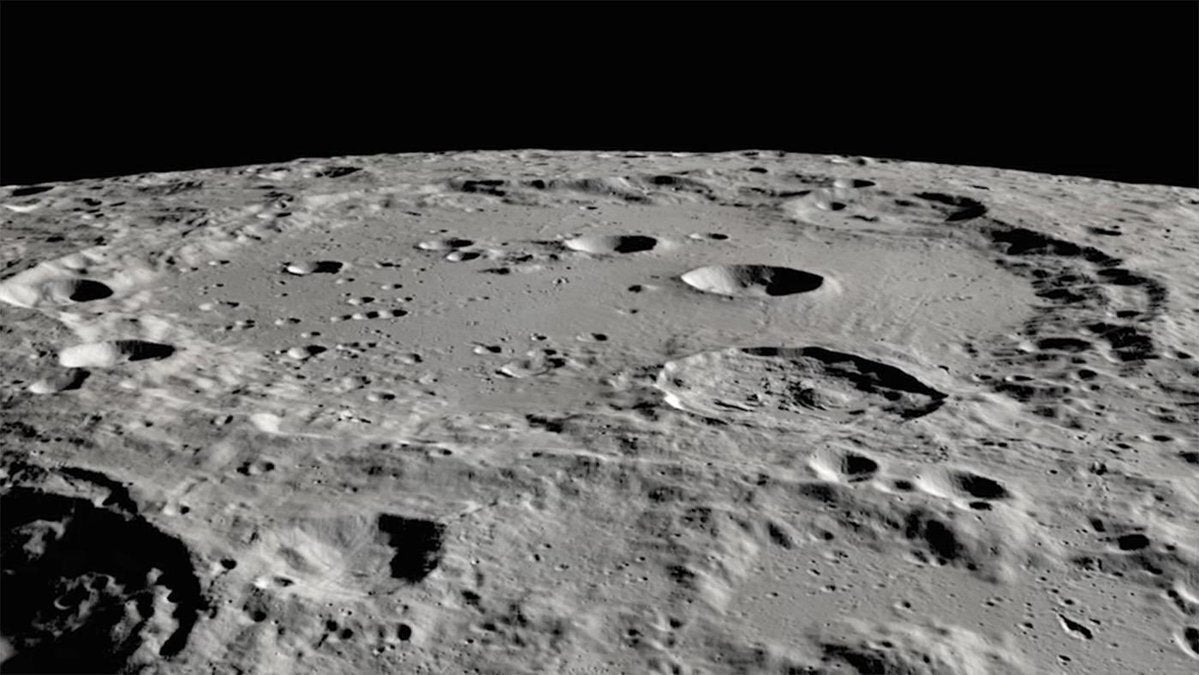NASA gained much of its notoriety from its success during the space race, culminating in landing men on the Moon. For some time now, the agency has been hard at work on its next-generation space transportation system to return crews to Earth’s only satellite for the first time in more than half a century. The program, collectively known as Artemis, aims to not only put humans back on the Moon, but to ultimately use the Moon itself as a stepping-stone to reach Mars.
Artemis, named for the twin sister of Apollo in Greek mythology, is as ambitious in scope as it is massive in scale. If successful, it will represent a monumental human achievement.
The Artemis program is built around several large-scale pieces of spaceflight hardware. Here, we provide an overview of the three most important components: the Space Launch System (SLS), the Orion spacecraft, and the Lunar Gateway station.
Space Launch System
SLS is the beating heart of Artemis. It is the heavy-lift launch vehicle that will get Artemis hardware first into orbit around Earth, then to the Moon. SLS is designed to be flexible, based on the needs of the mission: launching crew or cargo to Earth orbit, sending material and personnel to the Moon, etc. The rocket will thus be available in different configurations, known as blocks. The SLS Block 1 will be able to lift more than 59,000 pounds (26,760 kilograms) to the Moon; later versions will lift more than 100,000 pounds (45,360 kg) to the Moon. Crewed versions of the SLS will carry an escape system atop the Orion crew capsule, whereas cargo versions will not. SLS can carry payloads of various sizes using different launch fairings, depending on what a given mission requires. While all versions of the SLS are physically imposing, some will be even taller than the famed Saturn V rocket that took the Apollo astronauts to the Moon.
SLS consists of two solid rocket boosters (SRBs) attached to a central liquid-fueled core stage. Although on the surface, this looks a lot like the Space Shuttle Program’s launch vehicle, which consisted of two SRBs and an external tank, there are several key differences. SLS’ SRBs will consist of five segments each, compared with four segments for the shuttle’s SRBs. The larger SRBs will allow Artemis to send payloads beyond Earth’s orbit — something the shuttle’s SRBs could not do. These segments will initially be manufactured from leftover hardware from the shuttle program. After these leftover booster components are used up, Northrop Grumman will begin producing new SRB segments for later Artemis misisons.
The core stage, despite its familiar look, is fundamentally different than the shuttle’s external tank. The Artemis core stage, in addition to containing liquid hydrogen and oxygen fuel tanks, will house four RS-25 engines, while the shuttle’s external tank had no engines of its own and instead powered the shuttle orbiter’s three main RS-25 engines. Early Artemis flights will use upgraded leftover Space Shuttle Main Engines, or SSMEs, but later flights will use an improved version of this proven, reliable design. The core stage will hold more than 500,000 gallons (1.9 million liters) of liquid hydrogen and almost 200,000 gallons (757,000 l) of liquid oxygen. It is built at NASA’s Michoud Assembly Facility in New Orleans, which also built the Space Shuttle Program’s external tanks.
The Orion spacecraft
The Orion spacecraft, which will carry human crews, is analogous to the Apollo Command and Service Modules (CSM). Orion was originally designed to be part of NASA’s now-cancelled Constellation Program, which Artemis has since superseded. Lockheed Martin manufactures the spacecraft’s Crew Module (CM), which is coupled with an ESA-built Service Module (SM). Like Apollo’s CSM, Orion will also be topped by a launch escape system that fits over the CM. Its three solid rocket motors can be ignited if a situation arises requiring the astronauts to separate from SLS during launch.
The Orion CM is larger than its Apollo counterpart and can accommodate four astronauts per mission, as compared to Apollo’s three. With a diameter of 16.5 feet (5m; about 3 feet or 1m wider than Apollo), Orion’s extra space should come in handy during longer-duration missions. While the longest Apollo mission (Apollo 17) lasted about 12 and a half days, Orion is designed to accommodate spaceflights up to 21 days in length.
In contrast to Apollo’s crowded control panels, which featured hundreds of manual switches and controls designed to be operated by hands in bulky pressure suit gloves, Orion will be fully controllable via just a small number of flatscreen interfaces (similar to SpaceX’s manned Dragon spacecraft) with limited switches.
Nonetheless, Orion is markedly reminiscent of the Apollo design in several ways: The general shape of the two spacecraft is similar, and both make use of an ablative heat shield during re-entry into Earth’s atmosphere and parachutes to allow splashdown into the ocean. Interestingly, Textron, which acquired the company that developed the material for the Apollo heat shield, is also constructing the heat shield for Orion.
A key feature of Orion — and one that distinguishes it from Apollo — are its four solar panels. These panels, which will generate a combined 11 kilowatts of electricity, are stowed during launch and deployed once Orion is safely in space. Another critical difference from Apollo is that Orion will have the novel ability to function in a “quiescent” mode for up to 6 months, during which time the spacecraft can be docked with another piece of hardware (i.e., a space station). This is somewhat analogous to the manner in which Russian Soyuz spacecraft dock with the International Space Station (ISS) for extended periods of time.
Lunar Orbital Platform-Gateway
In contrast to SLS and Orion, which bear much similarity to prior space hardware, the Lunar Orbital Platform-Gateway (LOP-G; sometimes called Lunar Gateway or simply Gateway) is truly something original: a manned space station that will orbit the Moon. Gateway will be about 1/6 the size of the ISS. Nonetheless, it will serve a variety of functions: a local “mission control” for crewed missions to the lunar surface, a site for spacecraft to rendezvous on trips between the Moon and Earth, a platform for astronomical observations, a space-based science laboratory, and — perhaps one day — a launch point for missions to Mars.
Much like the ISS, Gateway will be constructed in stages, with different modules and components launched into space at different times. NASA has contracted with SpaceX to use its Falcon Heavy rocket to loft the first two components of the station into space: the Power and Propulsion Element (PPE) and the Habitation and Logistics Outpost (HALO). The PPE is a solar electric (ion) propulsion module that will allow Gateway to shift its orbit as needed, while HALO is a compact pressurized crew module that will also serve as a site for spacecraft to dock and as a communications hub. The pair will be integrated on the ground before launch. Other modules will join with PPE and HALO later on, including an additional planned habitation module.
Not all smooth sailing
NASA now plans to land humans on the moon again by 2025. Considering the relatively short timeline, some have wondered whether the agency is being foolishly optimistic or making compromises to stick to this schedule, especially given the enormous technical challenges and financial costs of the program. Development of the Artemis space suits alone is projected to cost $1 billion, and the entire project is currently estimated to cost $93 billion through 2025.
Gateway has also met with criticism, most notably by Apollo 11 moonwalker Buzz Aldrin and former NASA administrator Michael Griffin. Griffin pointed out the Gateway won’t really be useful until lunar landings are a reality again. For now, Gateway is still on the books to launch no earlier than November 2024, but things could always change.
NASA is clearly eager to move forward with Artemis, but the agency has had to contend with several setbacks, including the COVID-19 pandemic and related supply chain issues. It is worth noting that NASA has yet to launch the first uncrewed Artemis 1 mission, after scrubbing the first attempt at a wet dress rehearsal for the SLS in April. That three-day test is now rescheduled for June 18, after which NASA will discuss the results and a potential launch date.
The space race that spurred Apollo to the Moon had behind it much of the nation’s support and a meaningful deadline of Dec. 31, 1969, to land on the Moon. But Artemis is ultimately a different program for a different century — one that many feel will need to prove its value to succeed.












